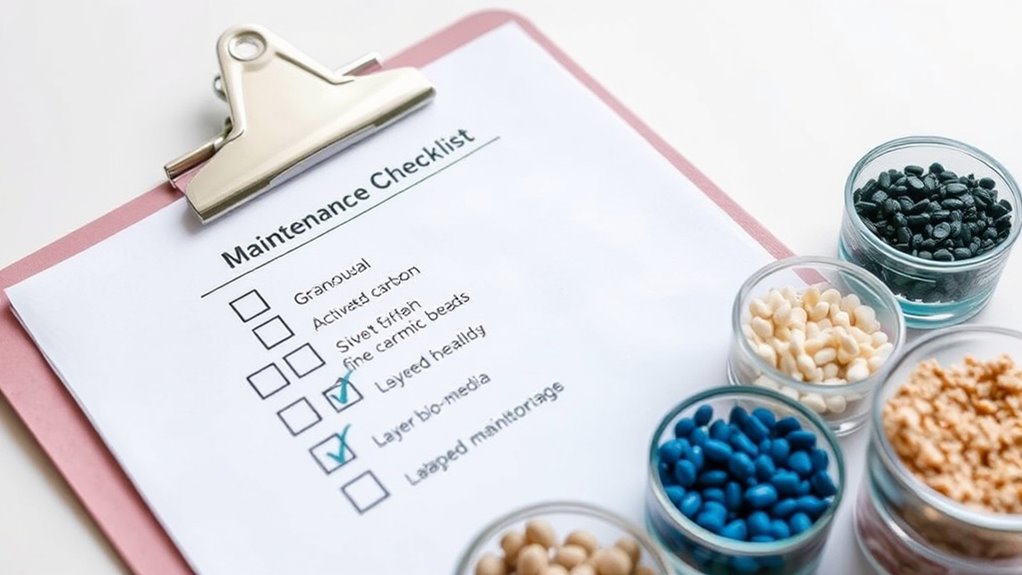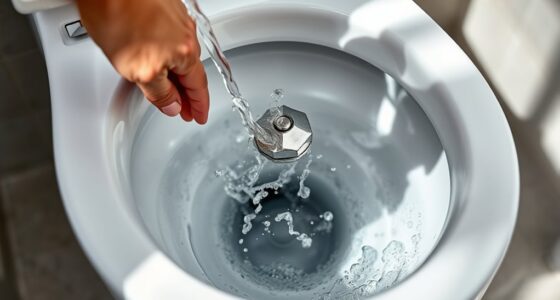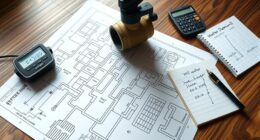Before you start, check your filter’s lifespan by reviewing manufacturer guidelines and noting usage patterns. Look for signs like reduced airflow, dirt buildup, or increased energy use, which signal it’s time for a replacement. Regular inspections help prevent system damage and guarantee ideal performance. Keep track of it with reminders or maintenance logs. Staying proactive now means fewer surprises later—continue with these tips to extend your filter’s effectiveness and maintain efficiency.
Key Takeaways
- Review manufacturer-recommended lifespan and replacement intervals for your specific filter media.
- Inspect the filter regularly for dirt, discoloration, or debris buildup, even if it isn’t yet due for replacement.
- Monitor system performance indicators such as airflow reduction and increased energy consumption.
- Keep detailed operational logs and usage frequency to inform maintenance timing.
- Set reminders via calendar or maintenance software to ensure timely filter checks and replacements.
Filter Replacement Signs and Schedule Tips

Have you ever wondered how often you should replace your filter media to keep your system running efficiently? Establishing a clear maintenance schedule is vital to ensuring your system performs at its best and avoids unnecessary breakdowns. The first step in this process involves understanding the key replacement indicators that signal when it’s time to swap out your filter media. By paying close attention to these signs, you can prevent clogged filters, improve air or fluid quality, and extend the lifespan of your equipment.
Your maintenance schedule should be based on a combination of manufacturer recommendations, usage patterns, and environmental conditions. Most filters have suggested replacement intervals—often every 1 to 3 months—but these can vary greatly depending on how heavily your system is used. For example, a filter in a high-traffic commercial space or a home with pets and smokers may need replacing sooner. Regularly reviewing your system’s operational logs or usage frequency can help you tailor a schedule that fits your specific situation. Setting reminders, whether through a calendar app or maintenance software, ensures you don’t forget these vital intervals.
Tailor your maintenance schedule based on manufacturer guidance, usage, and environment for optimal filter performance.
Replacement indicators are your best guides to knowing when it’s time for a change. Common signs include reduced airflow or fluid flow, which can indicate a clogged filter restricting performance. You might also notice an increase in energy consumption, as the system works harder to push air or fluid through a dirty filter. Visual cues are often clear: accumulated dirt, debris, or discoloration on the filter media itself. Some systems have built-in indicators or sensors that alert you when a filter needs attention, making it even easier to stay on top of maintenance. Additionally, understanding the HEPA filter lifespan can help you plan replacements more effectively for optimal air quality.
Don’t overlook the importance of inspecting your filter media regularly, even if no obvious indicators appear. Over time, even filters that still look relatively clean can become less effective at trapping contaminants. Establishing a consistent maintenance schedule helps you catch these issues early, preventing potential damage to your system and ensuring it runs smoothly. Keep in mind that over-replacing can also be a waste of resources, so learn to recognize the fine line between a filter that still functions and one that needs replacing.
Frequently Asked Questions
How Often Should I Check My Filter Media’s Lifespan?
You should check your filter media’s lifespan monthly through media inspection. Regular inspections help you spot signs of clogging or deterioration early, ensuring peak filter replacement timing. If you notice reduced flow or increased debris, it’s time to replace the media. Staying consistent with these checks keeps your system running efficiently and prolongs the life of your filter media, saving you money and maintaining clean air or water quality.
Can I Extend Filter Life With Proper Maintenance?
Yes, you can extend your filter’s life with proper maintenance. Regularly check the filter material for dirt and debris, cleaning or replacing it as needed. Follow a consistent replacement schedule to prevent clogging and guarantee peak performance. By maintaining your filter properly, you’ll reduce unnecessary replacement costs and improve air or water quality. Keep an eye on wear and tear, and don’t delay replacing the filter material when it shows signs of deterioration.
What Environmental Factors Affect Filter Media Longevity?
Environmental factors like water chemistry and biological growth markedly impact your filter media’s longevity. If your water has high levels of contaminants or imbalanced pH, it can cause faster wear and clogging. Additionally, biological growth such as algae or bacteria can accelerate media breakdown. To extend filter life, regularly monitor water chemistry, control biological growth, and perform routine maintenance to keep your filter functioning efficiently.
Are There Specific Signs of Filter Media Deterioration?
You’ll notice filter media deterioration through signs like discoloration, where the filter turns dark or stained, and odor changes, such as a musty or foul smell. These indicators suggest the filter is struggling to trap contaminants effectively. If you see discoloration or detect unusual odors, it’s time to replace or clean the filter to maintain peak performance and guarantee clean air or water quality.
How Do I Dispose of Used Filter Media Responsibly?
Think of your used filter media as a treasure chest of contaminants. To dispose of it responsibly, opt for eco-friendly disposal methods like designated waste programs or recycling options. Check local regulations for proper disposal guidelines, as many facilities now accept filter media for recycling. By doing so, you help protect the environment and promote sustainability, turning waste into a responsible, eco-conscious choice.
Conclusion
Think of your filter as a faithful garden hose—if it’s clogged or worn, water struggles to flow, leaving your plants thirsty and your system strained. Regular checks and timely replacements keep this essential lifeline clear and strong, ensuring everything runs smoothly. Remember, neglecting it is like ignoring a leak that slowly weakens your entire garden. Stay vigilant, replace when needed, and let your system flourish just like a well-tended garden—healthy, vibrant, and thriving.









